Юлия Павлова о Лесе, скорби и ловушках / Yulya Pavlova about the forest, traps and sorrow
Юлия Павлова – междисциплинарная художница, автор трех книг: Шурале, Грибы и О лесе, скорби и ловушках.
В работе над последней книгой я помогала Юлии в качестве куратора и необычайно рада, что книга завершена и сейчас готовится к печати в типографии. Накануне выхода тиража мы поговорили с Юлей о том, как родился этот проект и о фотокниге как явлении в целом.
Yulya Pavlova is an interdisciplinary artist, author of three books: Shurale, Mushrooms and Forest, Traps & Sorrow.
I helped Julia as a curator on the latter book and am extremely glad that the book is completed and is now being prepared for printing in the press. On the eve of the print run, we talked with Yulya about how this project was born and about the photobook as a phenomenon in general.

Юлия Бориссова (Ю.Б.): Юлия, мне кажется, что ты все больше погружаешься в создание фотокниг и стремишься развивать это направление в целом. Можешь ли объяснить своё увлечение этой формой высказывания?
Юлия Павлова (Ю.П.): Да, конечно. Для меня книжная форма - наиболее удобный и емкий формат чтобы придать идее “объем”, создать сложный нарратив. В книге художника (artistbook) я могу не только вести диалог со зрителем, но и буквально вести зрителя “за руку” к моей идее. Если рассматривать artistbook как медиум современного искусства, то можно увидеть как много смысловых слоев и ключей-подсказок к этим слоям может создать автор.
Julia Borissova (J.B.): Yulya, it seems to me that you are increasingly immersed in the creation of photobooks and strive to develop this field as a whole. Can you explain your passion for this form of expression?
Yulya Pavlova (Yu.P.): Yes, of course. For me, the book form is the most convenient and capacious format to give the idea “volume”, to create a complex narrative. In the artist's book I can not only conduct a dialogue with the viewer, but literally lead the viewer "by the hand" to my idea. If we consider the artistbook as a medium of contemporary art, then we can see how many semantic layers and clues to these layers the author can create.
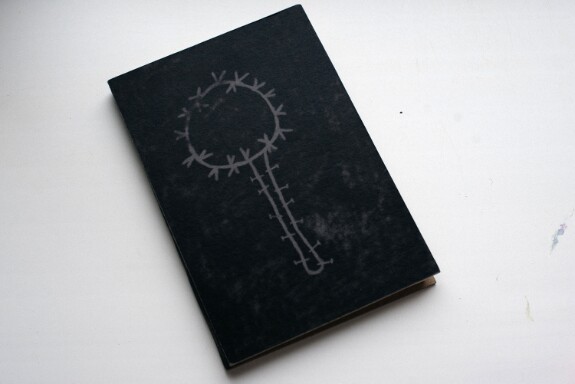
Forest, Traps & Sorrow (2023) by Yulya Pavlova
Ю.Б.: У меня складывается впечатление, что последнее время, а в случае с Россией буквально в последний год внимание к фотокнигам растет. Как ты думаешь, этот интерес захватывает художников из-за удобства презентации своего материала или есть ещё причины?
Ю.П.: У меня есть несколько версий. Первая - это действительно удобство. Можно развернуть идею в достаточно компактном формате. Плюс книги легко перевозить и отправлять в другие страны, в отличие от тех же скульптур или больших картин. Вторая версия - это “свежесть”. Мне кажется на российской арт сцене авторы, не знакомые с понятием концептуальной фотографии, до сих пор не очень понимают что такое книга художника и для многих это что-то новое и необычное. А потому модное и интересное. И третье - это цензура. Книгу, с одной стороны, сложнее цензурировать. А с другой стороны, в ней можно полнее высказываться.
J.B.: I have the impression that lately, and in the case of Russia, literally in the last year, attention to photobooks has been growing. Do you think this interest captures artists because of the convenience of presenting their material, or are there other reasons?
Yu.P.: I have several versions. The first is really convenience. You can deploy the idea in a fairly compact format. Plus, books are easy to transport and send to other countries, unlike the sculptures or large paintings. The second version is "freshness". It seems to me that on the Russian art scene, authors who are not familiar with the conceptual photography still do not really understand what an artist's book is, and for many it is something new and unusual. And therefore fashionable and interesting. And the third is censorship. The book, on the one hand, is more difficult to censor. On the other hand, you can express yourself more fully in it.
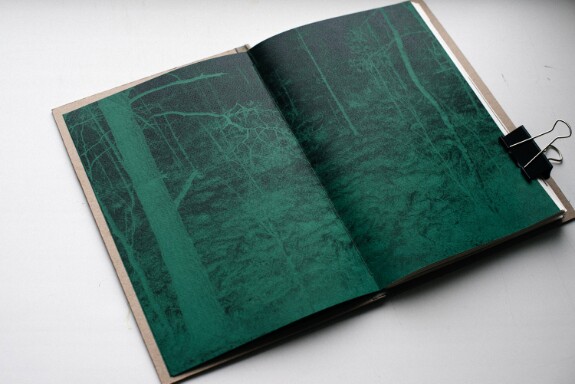
Forest, Traps & Sorrow (2023) by Yulya Pavlova
Ю.Б.: Можешь ли ты назвать русских авторов, работы которых привлекли твоё внимание?
Ю.П.: Конечно. Разумеется это твои книги. Их у меня в коллекции уже 5, и уверена что будут еще. Я собираю книги Екатерины Васильевой. Также мне нравятся книги Кристины Рожковой, Маши Ермоленко, Даши Назаровой, Яны Романовой. И не могу не сказать про книги Артура Бондаря и Оксаны Юшко. У нас много прекрасных и очень интересных авторов, за чьим творчеством я слежу.
J.B.: Can you name the Russian authors whose works attracted your attention?
Yu.P.: Sure. These are, of course, your books. I already have 5 of them in my collection, and I'm sure there will be more. I collect books by Ekaterina Vasilyeva. I also like books by Kristina Rozhkova, Masha Ermolenko, Dasha Nazarova, Yana Romanova. And I cannot but mention the books of Artur Bondar and Oksana Yushko. We have many wonderful and very interesting authors whose work I follow.

Black Stripe: The Experience of Creating the Mental Maps (2020) by Ekaterina Vasilyeva
Ю.Б.: Есть ли какие-то книги, которые вдохновили тебя на создание своих собственных?
Ю.П.: Да, безусловно. Первой книгой, которая меня впечатлила, была книга японского автора про смерть родителей (Junpei Ueda: Picture of My Life). У японцев вообще особая культура создания книг. Поэтому эта книга была полна загадок. Я почувствовала восторг, похожий на детский, когда листала ее. И поняла что хочу сделать нечто подобное. Потом я увидела вживую книги Kazuma Obara на его воркшопе. Он также привез много книг других известных авторов и все это открыло мне новый мир.
J.B.: Are there any books that inspired you to create your own?
Yu.P.: Yes, of course. The first book that impressed me was a Japanese author's book about the death of his parents (Junpei Ueda: Picture of My Life). The Japanese generally have a special culture of creating books. Therefore, this book was full of mysteries. I experienced childish delight when I leafed through it. And I realized that I want to do something similar. Then I saw Kazuma Obara's books at his workshop. He also brought back many books by other famous authors, and all this opened up a whole new world for me.
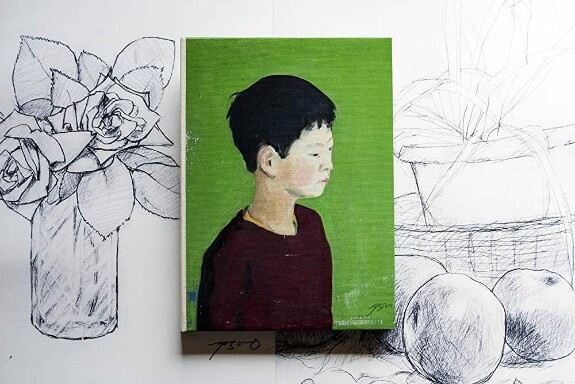
Picture of My Life (2017) by Junpei Ueda
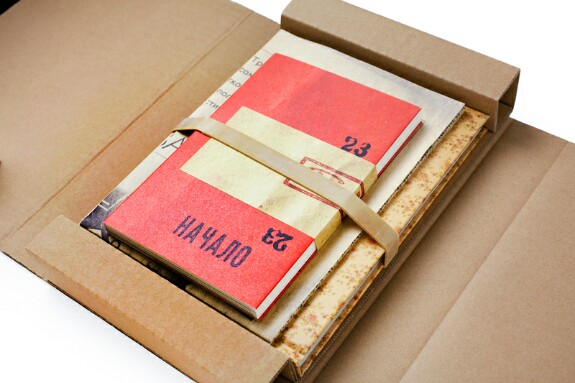
Exposure (2017) by Kazuma Obara
Ю.Б.: Считаешь ли ты что для создания книги достаточно одного стремления или необходимы и другие навыки?
Ю.П.: Я адепт той теории, что книга художника это сложный нарратив, требующий сформированной концепции. Авторскую книгу можно сравнить с понятием “кино на бумаге”. Приведу в пример себя - я училась в академии документальной и арт-фотографии “Фотографика”, на недельном воркшопе по созданию artist book у японского автора Казума Обара. Затем были авторские курсы Екатерины Васильевой и конечно же работа с тобой, как с куратором на протяжении 5 месяцев. Мне кажется в отношении авторской тиражной книги важно сказать, что концепция всегда первична. Качество бумаги, фотографий и другого визуального материала зависят и служат этой концепции. И в таком ключе толкования, конечно же, одного желания мало. Нужны знания, опыт взаимодействия с другими книгами, умение читать нарративы.
J.B.: Do you think that one desire is enough to create a book, or other skills are also necessary?
Yu.P.: I am an adherent of the theory that an artist's book is a complex narrative that requires a well-formed concept. The author's book can be compared with the concept of "cinema on paper". I’ll give myself as an example - I studied at the academy of documentary and art photography “Fotografika”, at a week-long workshop on creating an artist book with the Japanese author Kazuma Obara. Then there were the author's courses by Ekaterina Vasilyeva and, of course, work with you as a curator for 5 months. It seems to me that with regard to the author's printed book, it is important to say that the concept is always primary. The quality of paper, photographs and other visual material depend on and serve this concept. And in this vein of interpretation, of course, one desire is not enough. You need knowledge, experience of interacting with other books, the ability to read narratives.

Workshop of Kazuma Obara at the Academy Fotografika in 2018
Ю.Б.: В твоём случае, как ты начинаешь разрабатывать историю? Когда мы встретились первый раз по поводу твоей новой книги, мне кажется у тебя была идея рассказать историю о лесе, как месте для скорби и укрытия, как ты пришла к концепции ловушек?
Ю.П.: У меня в голове всегда сначала рождается образ мысли. Как у Вирджинии Вульф в "Своей комнате” - “Одна такая мысль ... уже соскользнула в воду и стала покачиваться там среди водорослей и отражений, то всплывая, то снова исчезая, как вдруг… вы ощутили, что у вас клюет..."
Когда мысль о лесе стала достаточно тяжела, я поняла что делать книгу только про него, будет поверхностно и скучно. И тут мне на помощь пришли две важные вещи - личный опыт и литература. Мой отец когда-то давно жил с лесничим. Он рассказывал о том, как они ставили ловушки на зверей. Так появилась мысль о “небезопасности”, о необходимости защиты своего убежища.
J.B.: In your case, how do you start developing a story? When we first met about your new book, I think you had the idea to tell a story about the forest as a place to sorrow and hide, how did you come up with the concept of traps?
Yu.P.: In my head, an image of thought is always born first. As with Virginia Woolf in “A room of one's own” - “Thought...had let its line down into the stream. It swayed, minute after minute, hither and thither among the reflections and the weeds, letting the water lift it and sink it, until—you know the little tug—the sudden conglomeration of an idea at the end of one’s line: and then the cautious hauling of it in, and the careful laying ...”
When the thought of the forest became heavy enough, I realized that making a book only about it would be superficial and boring. And then two important things came to my aid - personal experience and literature. My father used to live with a forester a long time ago. He talked about how they set traps for animals. This is how the idea of "insecurity" appeared, about the need to protect one's shelter.


Forest, Traps & Sorrow (2023) by Yulya Pavlova
Ю.Б.: Я помню наше обсуждение фильмов, которые могли бы дать тебе визуальный толчок к созданию образов, можешь рассказать об этом подробнее?
Ю.П.: С удовольствием! Вообще работа над книгой, как над отдельным высказыванием, напоминает мне работу исследователя. Визуальный и интеллектуальный ресерч отдельная приятная часть работы. На одной из наших с тобой встреч ты посоветовала посмотреть мне фильм Рустама Хамдамова “Мешок без дна” и эстонский фильм “Ноябрь”. Эстетика этих фильмов очень полно отражала то, что я хотела показать в своей книге как автор. Поэтому я взяла некоторые визуальные подсказки из этих фильмов и интерпретировала в книге. Но, разумеется, на свой лад. Эти отсылки видны на кадре с висящей приманкой и черепом животного.
J.B.: I remember our discussion of films that could give you a visual impetus to create images, can you tell more about this?
Yu.P.: With pleasure! In general, working on a book, as on a separate statement, reminds me of the work of a researcher. Visual and intellectual research is a separate pleasant part of the work. At one of our meetings with you, you advised me to watch Rustam Khamdamov's film “The Bottomless Bag” and the Estonian film “November”. The aesthetics of these films very fully reflected what I wanted to show in my book as an author. So I took some of the visual cues from those films and interpreted them in the book. But, of course, in my own way. These references are visible in the frame with the hanging bait and the skull of the animal.
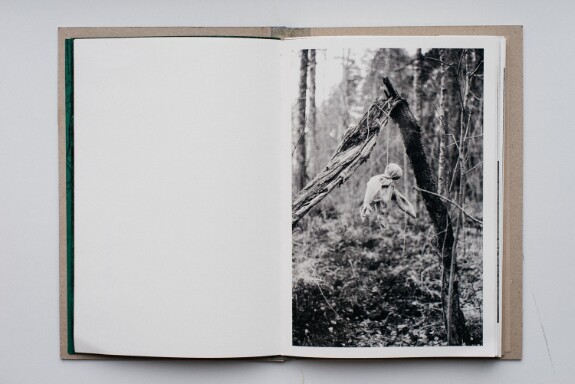
Forest, Traps & Sorrow (2023) by Yulya Pavlova
Ю.Б.: Ты используешь в книге цитаты из Юнгера и Ямпольского. Что было первым - чтение текста, а потом идея проекта? или наоборот, сначала сформировалась концепция истории, а тексты только подкрепили твое высказывание?
Как ты считаешь, можно было обойтись без цитат, ограничившись только авторским текстом? Я задаю этот вопрос, потому что мне кажется, что многие начинающие авторы стесняются взаимодействовать с печатным словом, считая, что фотографии должны говорить сами за себя. Можешь дать совет, исходя из своего опыта?
Ю.П.: Сначала была идея о лесе, как о некоем мистическом месте… наверное, как зона в “Сталкере” Андрея Тарковского. Затем личная история об отце. И тут уже на помощь пришли книги. Мне кажется без литературы можно уйти в бесконечную саморефлексию. Книги же помогают балансировать и укрепить высказывание. Я брала как и прямые цитаты из книг, так и визуально ссылаясь на что-то. Концепция идеи сменяемости ролей охотника и жертвы была придумана после прочтения Ямпольского. Я считаю что такой медиум как современная фотография играет на поле современного искусства. Поэтому сама по себе она читаться на обязана. Нужны “ключи” в виде текстов, отсылок, подсказок.
J.B.: You use quotes from Jünger and Iampolski in the book. What came first - reading the text, and then the idea of the project? or vice versa, did the concept of the story form at first, and the texts only supported your statement?
Do you think it was possible to do without quotations, limiting yourself to only the author's text? I ask this question because it seems to me that many aspiring authors are embarrassed to interact with the printed word, believing that photographs should speak for themselves. Can you give advice based on your experience?
Yu.P.: At first there was an idea about the forest as some kind of mystical place… probably, like a zone in Andrey Tarkovsky's Stalker. Then there was a personal story about my father. And this is where books come in. It seems to me that without literature one can go into endless self-reflection. Books help to balance and reinforce the statement. I took both: direct quotes from books, and visually referring to something. The concept of the idea of changing the roles of the hunter and the victim was invented after reading Iampolski I believe that such a medium as modern photography plays in the field of contemporary art. Therefore, in itself, it is not obliged to be read. We need “keys” in the form of texts, references, hints.
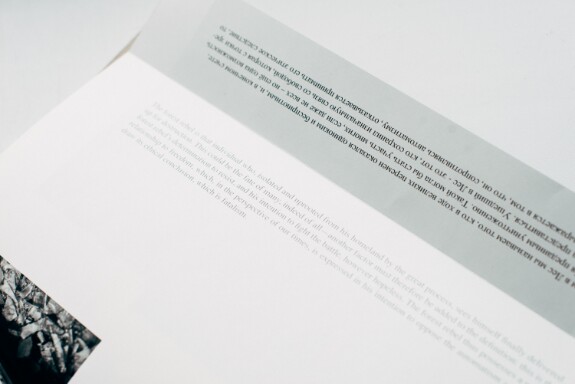
Forest, Traps & Sorrow (2023) by Yulya Pavlova
Ю.Б.: Насколько важна личная составляющая проекта? Возможно ли создать книгу без персонального вовлечения в тему?
Ю.П.: Я думаю что личное отношение автора к теме важно. Оно может быть прямое, как у меня, или косвенное. Но без персонального вовлечения автору будет сложно работать над чем-то длительное время.
J.B.: How important is the personal component of the project? Is it possible to create a book without personal involvement in the topic?
Yu.P.: I think that the author's personal attitude to the topic is important. It can be direct, like mine, or indirect. But without personal involvement, it will be difficult for the author to work on something for a long time.
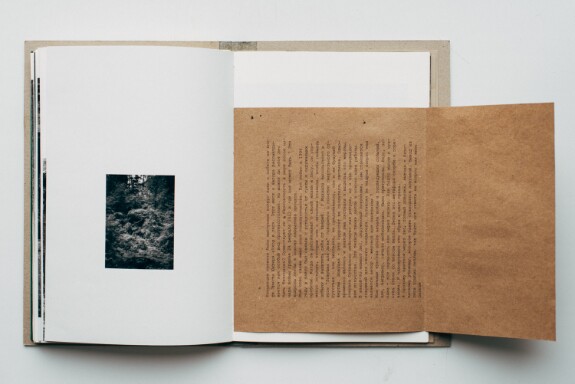
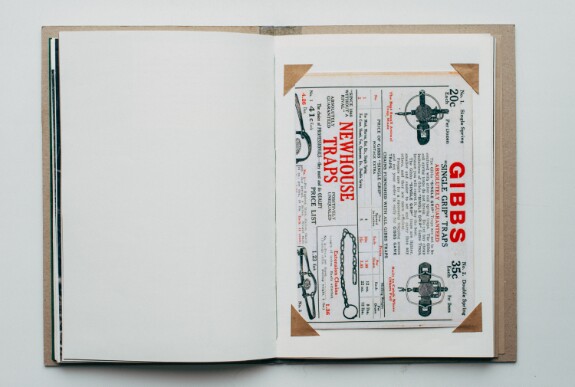
Forest, Traps & Sorrow (2023) by Yulya Pavlova
Ю.Б.: Вопрос о книге, как объекте - можешь перечислить этапы конструирования и выбора материала (бумаги и т.п.), как ты пришла к конечной форме?
Ю.П.: Конечно. Первоначально я думала печатать книгу на желтоватой небеленой бумаге, но потом , уже в типографии, остановила выбор на матовой бумаге не такого насыщенно-желтого оттенка. Вообще в книге используется много разной бумаги: зеленая для печати инвертированных фотографий леса, серый крафт для пепла, небеленая бумага для рисунков и записок. И я молчу о кусочках кальки и других мелочах. Сама форма книги немного вытянута, что отсылает к стволу дерева. Отдельно стоит сказать об обложке - на одной из встреч мы с тобой думали как сделать ее более текстурной. В типографии мне помогли решить эту задачу при помощи необычной бумаги. Многие, кто видел обложку, думали что она покрыта лаком, но это не так.
J.B.: A question about a book as an object - can you list the stages of designing and choosing a material (paper, etc.), how did you come to the final form?
Yu.P.: Of course. Initially, I thought of printing the book on yellowish unbleached paper, but then, already at the printing house, I opted for matte paper of a less saturated yellow hue. In general, a lot of different paper is used in the book: green for printing inverted photographs of the forest, gray craft for ashes, unbleached paper for drawings and notes. And I am silent about pieces of tracing paper and other trifles. The shape of the book itself is slightly elongated, which refers to the tree trunk. Separately, it is worth mentioning the cover - at one of the meetings, you and I thought about how to make it more textured. The printing house helped me solve this problem with the help of unusual paper. Many who saw the cover thought that it was varnished, but it is not.
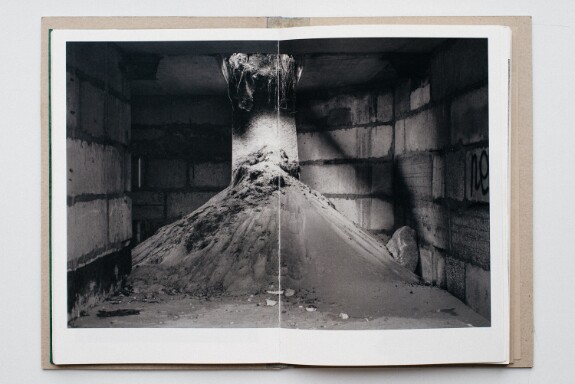
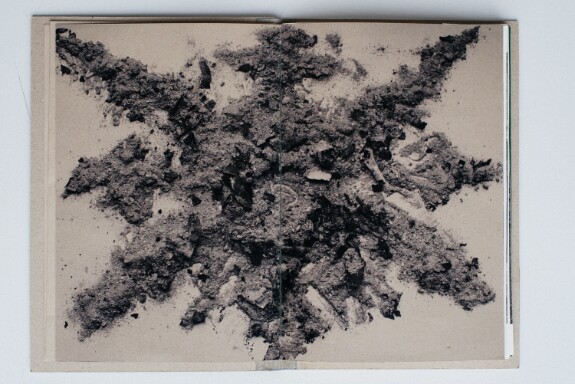
Forest, Traps & Sorrow (2023) by Yulya Pavlova
Ю.Б.: Юля, я хочу тебя поздравить еще раз, что книга "О лесе, скорби и ловушках" сложилась в законченное высказывание и ты уже презентовала дамми на персональной выставке в галерее НеНеМу (Негосударственный Нерусский Музей). На сколько важен публичный показ завершённой работы?
Ю.П.: Для меня выставка была очень важной частью работы по нескольким причинам. Такое привлечение внимания к книге позволило мне, как автору, лично рассказать всем пришедшим зрителям как устроена книга. Мне действительно хотелось донести свою мысль и я старалась поговорить практически с каждым, кто пришел. Во-вторых выставка помогла мне собрать деньги на тираж. Все, кто работает с самиздатом, знают как это непросто. У нас нет грантовых программ в этой сфере, как в тех же Европейских странах. И авторам в России приходится объявлять сборы на краундфаундинговых платформах, брать кредиты или просто не выпускать книги. Поэтому решение с выставкой оказалось очень коммерчески оправданным.
J.B.: Yulya, I want to congratulate you once again that the book "Forest, Traps & Sorrow" has turned into a complete statement and you have already presented dummy at a personal exhibition in the NeNeMu Gallery (Not Russian Museum). How important is the public display of completed work?
Yu.P.: For me, the exhibition was a very important part of my work for several reasons. This attraction of attention to the book allowed me, as an author, to personally tell all the viewers who came how the book works. I really wanted to get my point across and I tried to talk to almost everyone who came. Secondly, the exhibition helped me raise money for the circulation. Everyone who works with selfpublishing knows how difficult it is. We do not have grant programs in this area, as in the same European countries. And authors in Russia have to look fees on crowdfunding platforms, take out loans, or simply not release books. Therefore, the decision with the exhibition turned out to be very commercially justified.
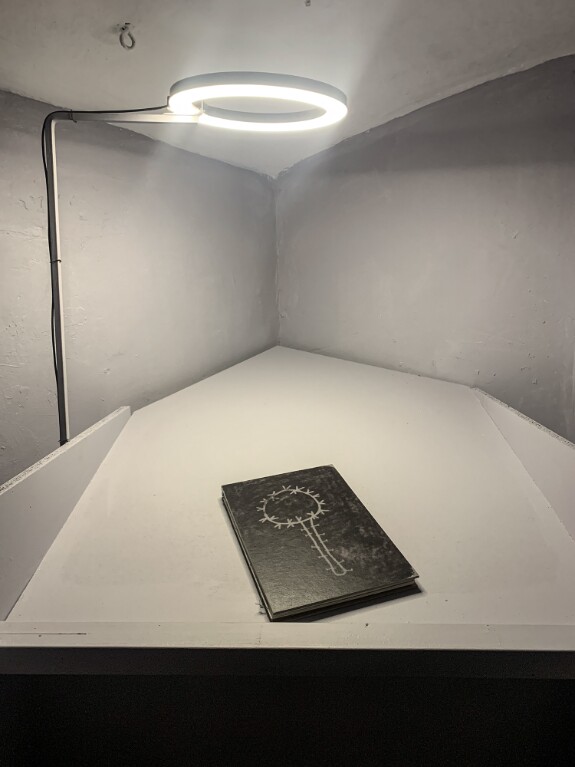
Книга "О лесе, скорби и ловушках" на выставке в Негосударственном Нерусском Музее, куратор Александр Дашевский / The book "Forest, Traps & Sorrow" at the exhibition in the Not Russian Museum, curated by Alexander Dashevsky
Ю.Б.: И в заключение вопрос, который я задаю всем в своём исследовании феномена фотокниги. Что же такое фотокнига и чем она отличается от книги художника?
Ю.П.: Для меня книга художника это сложное визуальное повествование, собранное вокруг некой концепции. Фотокнига в моем понимании это презентация работ автора в выгодном ключе. У них разные задачи и способы реализации. Я начинающий коллекционер и конечно же я собираю книги художника. Но это не мешает мне приобретать фотокниги других авторов, чтобы иметь под рукой любимые работы.
J.B.: And in conclusion, the question that I ask everyone in my research of the photobook phenomenon. What is a photobook and how does it differ from an artist's book?
Yu.P.: For me, an artist's book is a complex visual narrative, gathered around a certain concept. Photobook in my understanding is a presentation of the author's work in a favorable way. They have different tasks and ways of implementation. I am a beginner collector and of course I collect artist's books. But this does not prevent me from purchasing photobooks of other authors in order to have my favorite works at hand.
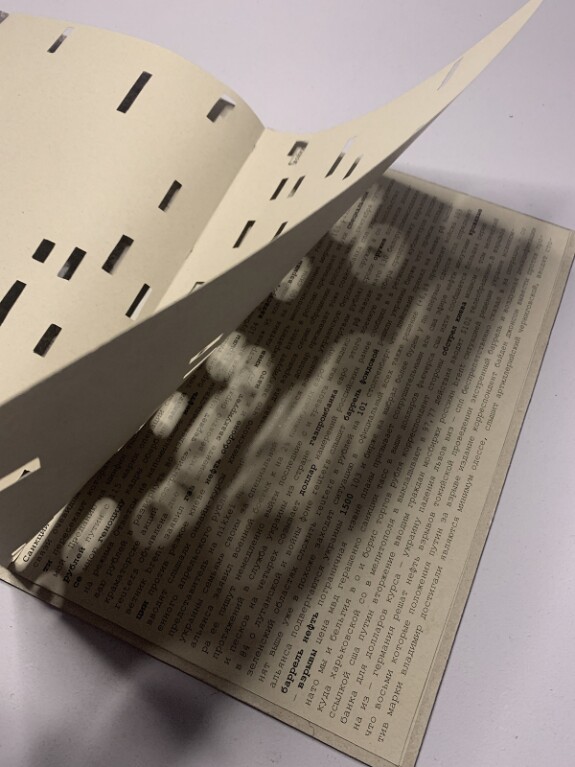
Юлия Павлова
Размер книги: 18x27см
52 страницы
Открытый переплёт
Лимитированный тираж 70 экземпляров + 4 копии специальное издание
Каждая книга полностью собрана вручную
52 страницы
Открытый переплёт
Лимитированный тираж 70 экземпляров + 4 копии специальное издание
Каждая книга полностью собрана вручную
Чтобы заказать книгу, пишите на почту yulya.pavlova.art@gmail.com
Yulya Pavlova
Book size: 18x27cm
52 pages
Open bound
Limited edition of 70 copies + 4 copies special edition
Each book is fully assembled by hand
To order the book please contact at email: yulya.pavlova.art@gmail.com






